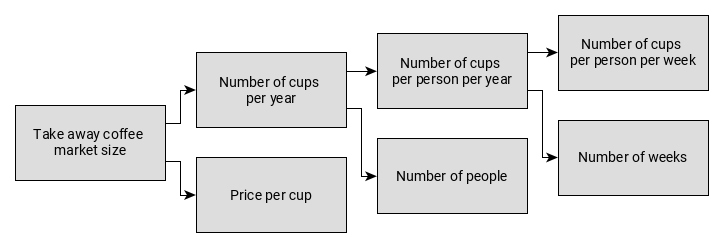Guesstimate cases are generally used as part of a 1st round interviews to warm a candidate up for a full case later during the interview process. Consulting firms use guesstimates / market sizing questions to test the quantitative ability, numerical thinking & judgment to arrive at reasonable solutions. For instance your interviewer might ask:
How many takeaway coffees are sold every day in Paris?
This type of question can really feel unsettling at first. But, like business cases, there isn’t necessarily a right or wrong answer. The reality is that the interviewer probably has no idea what the real answer to the guesstimates question is – nor do they even really care. These cases are simply a way for them to test your logical thinking & see if you are able to communicate & justify your rationale out loud. The good news is that if you know how to approach them, they can become fairly easy to answer.
Our Framework
We recommend using a 4-step approach to answering guesstimates questions:
- Clarify
- Map
- Calculate
- Validate
Clarify: Ask clarifying questions
The first thing you should do is ask a few clarification questions to make sure that you know exactly what number you need to calculate. For example, if the interviewer asks:
What’s the market size for takeaway coffee in Paris?
Here are a few important clarification questions you could ask:
- Do we want to calculate the number of cups sold per year? Or, how much money consumers spend on takeaway coffee?
- Can I confirm that we are only interested in takeaway coffee?
- Can I exclude coffees consumed inside coffee shops?
- Are we interested in the whole Paris metropolitan area (12 million population) or just Paris City (2m population)?
These questions help you make sure that you calculate exactly what your interviewer wants you to. In addition, they are also a great way to buy yourself some time.
Map: Map out your calculations
Once you know exactly what number your interviewer wants you to calculate, you need to map the calculation steps to get to that number. Let’s imagine we want to calculate the amount spent (€) on takeaway coffee in the whole Paris metropolitan area (excluding coffee consumed in shops). Here is a step-by-step approach that you could use to calculate that number:
- The number of takeaway cups per week for an average Parisienne
- Annual number of cups consumed by the whole of Paris
- The corresponding market size (€ value)
If you find it difficult to naturally list these steps, an alternative approach is to start from the number you want to calculate and draw an issue tree as shown below. The advantage of that approach is that the issue tree will force you to be MECE & it will also give you a starting point.

At this juncture, you should validate your approach with your interviewer before proceeding to the next step i.e. number crunching. This is important because it gives your interviewer a chance to rectify your course of action. Proceeding to the calculation step without validation is extremely risky; you might be approaching the problem differently from how the interviewer envisioned. If you don’t validate, you might proceed on the wrong trajectory. The interviewer might find it out only when it’s too late & you might not be able to recover.
Calculate: Round numbers & calculate
Once you’ve ratified your approach with the interviewer, it’s time to crunch some numbers. You will need various data points to get to your final estimate. In most cases, your interviewer will ask you to make your own assumptions to get to the final number. But, in other cases, they might share some data with you. The best way to figure this out is to say something like:
Ok, now that we agree on the approach, let me start estimating the market size. Shall I make my own assumptions? Or do you have any data that I should use?
Most of the time they’ll say you should make your own assumptions. But, it doesn’t hurt to double check.
The interviewers expect you to make reasonable assumptions while solving guesstimates questions. When making assumptions, it is also important that you pick simple numbers you can easily calculate with. For example, you could use 350 days a year instead of 365. Also, rounding numbers will make your calculations easier & decrease your likelihood of making a mistake. While calculating, you should talk out loud so your interviewer can follow your thought process. Your interviewer is interested in your thought process; not the final result.
Validate: Sanity check your results
Most candidates stop talking after they finished their calculations. They look up & expect their interviewer to tell them if they got to the right result or not. This is an error! The best candidates validate their results & try to spot their own mistake before telling their interviewer they are done.




